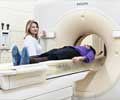For epidural steroid injections, the radiation dose for a CT fluoroscopy is about half that for conventional fluoroscopy, shows study.
Physicians may hesitate to use CT fluoroscopy because of concerns about radiation dose, said Jenny K. Hoang, MD of Duke University Medical Center, and one of the authors of the study. However, the study found that since CT fluoroscopy itself takes less time than conventional fluoroscopy (4.7 seconds versus 37 seconds on average), the radiation dose is actually much lower. The study found that absorbed radiation dose to the skin, small bowel, large bowel and bone marrow was greater for conventional fluoroscopy compared with CT fluoroscopy. However, when you combine the dose of the planning CT (scan range from L2 to S1) with that of the CT fluoroscopy itself, the dose is four times higher compared to conventional fluoroscopy, Dr. Hoang said. "The main source of radiation dose from CT-guided lumbar pain injections is the lumbar spine preliminary planning CT," said Dr. Hoang. "Radiologists performing CT fluoroscopy should consider techniques to reduce radiation dose for the planning CT such as reducing the coverage to only areas of interest and reducing the tube current or peak kilovoltage. In this study we considered the maximum z-axis possible for the planning CT. In most cases this can be reduced to one intervertebral level if there is a good history that identifies the level affected and/or if there is prior diagnostic imaging," she said.
CT fluoroscopy has several advantages over conventional fluoroscopy, added Dr. Hoang. CT fluoroscopy is better able to show soft tissue so the needle can be more accurately positioned for the spine injection; in addition, less iodinated contrast media is needed, she said.
Dr. Hoang emphasized that the study results are based on the protocols they use at her institution. "Radiation dose values are highly dependent on the fluoroscopy time used by the individual doing the procedure and the dose settings that are used at his or her institution," she said.
The study is published in the October, 2011
American Journal of Roentgenology.
Source-Eurekalert














